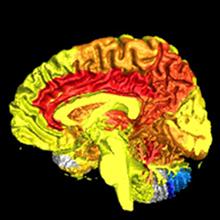7 August 2017

Largest functional brain imaging study to date identifies specific brain differences between women and men, according to a new report in the Journal of Alzheimer’s Disease
Amsterdam, NL – In the largest functional brain imaging study to date, the Amen Clinics (Newport Beach, CA) compared 46,034 brain SPECT (single photon emission computed tomography) imaging studies provided by nine clinics, quantifying differences between the brains of men and women. The study is published in the Journal of Alzheimer’s Disease.
Lead author, psychiatrist Daniel G. Amen, MD, founder of Amen Clinics, Inc., commented, “This is a very important study to help understand gender-based brain differences. The quantifiable differences we identified between men and women are important for understanding gender-based risk for brain disorders such as Alzheimer’s disease. Using functional neuroimaging tools, such as SPECT, are essential to developing precision medicine brain treatments in the future.”
The brains of women in the study were significantly more active in many more areas of the brain than men, especially in the prefrontal cortex, involved with focus and impulse control, and the limbic or emotional areas of the brain, involved with mood and anxiety. The visual and coordination centers of the brain were more active in men. SPECT can measure blood perfusion in the brain. Images acquired from subjects at rest or while performing various cognitive tasks will show different blood flow in specific brain regions.
Subjects included 119 healthy volunteers and 26,683 patients with a variety of psychiatric conditions such as brain trauma, bipolar disorders, mood disorders, schizophrenia/psychotic disorders, and attention deficit hyperactivity disorder (ADHD). A total of 128 brain regions were analyzed for subjects at baseline and while performing a concentration task.

Caption: Side view of the brain summarizing blood flow results from tens of thousands of study subjects shows increased blood flow in women compared to men, highlighted in the red colored areas of the brain: the cingulate gyrus and precuneus. Men in this image have higher blood flow in blue colored areas – the cerebellum.
Understanding these differences is important because brain disorders affect men and women differently. Women have significantly higher rates of Alzheimer’s disease, depression, which is itself is a risk factor for Alzheimer’s disease, and anxiety disorders, while men have higher rates of (ADHD), conduct-related problems, and incarceration (by 1,400%).
Editor-in-Chief of the Journal of Alzheimer’s Disease and Dean of the College of Sciences at The University of Texas at San Antonio, Dr. George Perry said, “Precisely defining the physiological and structural basis of gender differences in brain function will illuminate Alzheimer’s disease and understanding our partners.”
The study findings of increased prefrontal cortex blood flow in women compared to men may explain why women tend to exhibit greater strengths in the areas of empathy, intuition, collaboration, self-control, and appropriate concern. The study also found increased blood flow in limbic areas of the brains of women, which may also partially explain why women are more vulnerable to anxiety, depression, insomnia, and eating disorders.
# # #
NOTES FOR EDITORS
“Gender Based Cerebral Perfusion Differences in 46,034 Functional Neuroimaging Scans,” by Daniel G. Amen, MD, Manuel Trujillo, MD, David Keator, MS, Derek V. Taylor, Kristen Willeumier, PhD, Somayeh Meysami, MD, and Cyrus A. Raji, MD, PhD (DOI: 10.3233/JAD-170432) is published online in advance of the Journal of Alzheimer’s Disease, Volume 60, Issue 2 (September 2017) by IOS Press.
Daniel G. Amen, MD is a psychiatrist, brain imaging expert, and founder of Amen Clinics in Costa Mesa and Walnut Creek, CA, Bellevue, WA, Reston, VA (DC area), Atlanta, GA, Chicago, IL, and New York, NY. He is the author of Memory Rescue (to be released 11/14/2017) and Change Your Brain, Change Your Life.
Full text of the paper is available to credentialed journalists upon request; contact Carmel McNamara at +31 20 688 3355 or c.mcnamara@iospress.nl. Journalists who wish to reach the authors for comment should contact Daniel G. Amen, MD, at docamen@amenclinics.com.
ABOUT THE JOURNAL OF ALZHEIMER’S DISEASE
The Journal of Alzheimer's Disease (http://www.j-alz.com) is an international multidisciplinary journal to facilitate progress in understanding the etiology, pathogenesis, epidemiology, genetics, behavior, treatment and psychology of Alzheimer's disease. The journal publishes research reports, reviews, short communications, book reviews, and letters-to-the-editor. Groundbreaking research that has appeared in the journal includes novel therapeutic targets, mechanisms of disease and clinical trial outcomes. The Journal of Alzheimer's Disease has an Impact Factor of 3.731 according to the 2016 Journal Citation Reports® (Clarivate Analytics, 2017).
ABOUT IOS PRESS
Celebrating its 30th anniversary, IOS Press (www.iospress.com) is headquartered in Amsterdam with satellite offices in the USA, Germany, India and China and serves the information needs of scientific and medical communities worldwide. IOS Press now publishes over 100 international journals and about 75 book titles each year on subjects ranging from computer sciences and mathematics to medicine and the natural sciences.
Contacts:
George Perry, PhD
Editor-in-Chief, Journal of Alzheimer's Disease
Dean and Professor of Biology, The University of Texas at San Antonio
+1 210 458 4450
george.perry@utsa.edu
Carmel McNamara
IOS Press
+31 20 688 3355
C.McNamara@iospress.nl
www.j-alz.com







